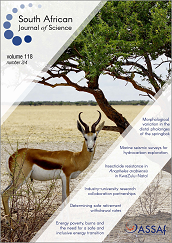Isotopic profiling of natural uranium mined from northern Nigeria for nuclear forensic application
DOI:
https://doi.org/10.17159/sajs.2022/10678Keywords:
isotopic profile, natural uranium, U-Th-Pb concentration, nuclear forensics, uranium isotope ratioAbstract
Four mined samples of natural uranium from northern Nigeria were studied through inductively coupled plasma mass spectrometry, at the Environmental Analytical Chemistry Laboratory, University of the Witwatersrand, Johannesburg. The samples were characterised for lead, thorium and uranium isotopic concentrations, isotopic ratios and age. The objective was to obtain nuclear forensic fingerprints as baseline data to add to the Nigerian National Nuclear Forensic Library. Results showed significant variation in the isotopic concentrations of lead, thorium and uranium across the mines. Isotopic ratios of 238U/235U, 235U/238U and 234U/238U across the sample of 137.881±0.007, 7.253×10-03±2.05×10-04 and 5.540×10-05±4.08×10-07 were found to be consistent with the natural values. The age of natural uranium is comparable to the age of earth. Uranium, lead, and thorium isotopic concentrations and ratios, as well as the age of the samples characterised, provide an isotopic profile that can be used for nuclear forensic application.
Significance:
- Given the abundant deposits of natural uranium in Africa and the consequent potential for nuclear insecurity, determining the isotopic profiles and signatures of natural uranium is important for application in nuclear forensics.
- Isotopic concentrations of 232Th, 238U, 235U and 234U from the respective sampling sites differed significantly, thereby providing characteristic isotopic profiles.
Published
Issue
Section
License

All articles are published under a Creative Commons Attribution 4.0 International Licence
Copyright is retained by the authors. Readers are welcome to reproduce, share and adapt the content without permission provided the source is attributed.
Disclaimer: The publisher and editors accept no responsibility for statements made by the authors
How to Cite
- Abstract 599
- PDF 940
- EPUB 538
- XML 530












.png)